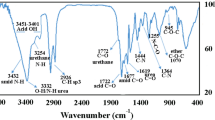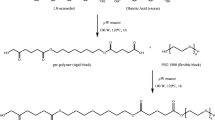Abstract
Biodegradable and biocompatible polymers play a key role to provide a solution for sustained chemotherapy, when engineered to nanostructure. One such effort has been put forward to engineer self-assembled poly(caprolactone)-grafted dextran (PGD) core–shell micellar vehicle for anticancer drug (paclitaxel) and presented in this study. Paclitaxel-loaded PGD nanoparticles (NPs) were prepared by a modified oil/water emulsion method and characterized by laser light scattering, atomic force microscopy, and zeta potential measurements. The effects of the copolymeric compositions of PGD NPs on drug encapsulation efficiency, in vitro drug release, cellular uptake, and cell viability of NP formulation with paclitaxel were investigated. The drug encapsulation efficiency was determined spectrophotometrically, and in vitro drug release was estimated using dialysis bag. Human gastric cancer cell line (SNU-638) were used to image and measure the cellular uptake of fluorescent PGD NPs. Cancer cell viability of the drug-loaded PGD NPs was measured by crystal violet staining method. From the results obtained on various aspects, we inferred that the above formulated drug-loaded PGD NPs have significant drug encapsulation efficiency, cellular uptake, and the cancer cell mortality.






Similar content being viewed by others
References
Feng SS, Mu L, Win K, Huang GF. Nanoparticles of biodegradable polymers for clinical administration of paclitaxel. Curr Med Chem. 2004;24:413–24.
Feng SS, Chien S. Chemotherapeutic engineering: application and further development of chemical engineering principles for chemotherapy of cancer and other diseases. Chem Eng Sci. 2003;58:4087–114.
Cancer nanotechnology: going small for big advances—using nanotechnology to advance cancer diagnosis, prevention and treatment. US Department of Health & Human Service, National Institute of Health and National Cancer Institute 2004.
Feng SS. Nanoparticles of biodegradable polymers for new concept chemotherapy. Expert Rev Med Dev. 2003;1:115–25.
Petrak K. Design and properties of particulate carriers for intravascular administration drugs. Pharm Sci. 1993;61:275–97.
Ajani JA, Takiuchi H. Recent developments in oral chemotherapy options for gastric carcinoma. Drugs. 1997;58:85–90.
DeMario MD, Ratain MJ. Oral chemotherapy: rationale and future directions. J Clinc Oncol. 1999;16:2557–67.
Bottomle B. The cancer patient and quality of life. The Oncologist. 2002;7:120–5.
Grislain L, Couvreur P, Lenaerts V, Roland M, Deprezdecampeneere D, Speiser P. Pharmacokinetics and distribution of a biodegradable drug carrier. Int J Pharm. 1983;15:335–45.
Gregoriadis G. Drug carriers in biology and medicine. London: Academic; 1979. p. 107.
Poznansky MJ, Cleland LG. Drug delivery systems. New York: Oxford University Press; 1980. p. 253.
Sery TW, Hehre EJ. Degradation of dextrans by enzymes of intestinal bacteria. J Bact. 1956;71:373–80.
Passirani C, Barratt G, Devissaguet JP, Labarre D. Interactions of nanoparticles bearing heparin or dextran covalently bound to poly(methylmethacrylate) with the complement system. Life Sci. 1998;62:758–75.
Jaulin NM, Appel MC, Passirani CG, Barratt G, Labarre D. Reduction of the uptake by a macrophagic cell line of nanoparticles bearing heparin or dextran covalently bound to poly(-methyl methacrylate). J Drug Target. 2000;8:165–72.
Passirani C, Barratt CG, Devissaguet JP, Labarre D. Long circulating nanoparticles bearing heparin of dextran covalently bound to poly(methyl methacrylate). Pharm Res. 1998;15:1046–50.
Chauvierre C, Labarre D, Couvreur P, Vauthier C. Radical emulsion polymerization of alkylcyanoacrylates initiated by the redox system dextran-cerium (IV) under acidic aqueous conditions. Macromolecules. 2003;36:6018–27.
Larsen C, Harboe E, Johansen M, Olesen HP. Macromolecular produgs XVI. Colon-targeted delivery comparison of the rate of release of naproxen from dextran ester prodrugs in homogenates of various segments of the pig gastrointestinal (GI) tract. Pharm Res. 1989;5:995–9.
Gupta AK, Gupta M. Synthesis and surface engineering of iron oxide nanoparticles for biomedical applications. Biomaterials. 2005;26:3995–4021.
Malingre MM, Beijnen JH, Schellens JHE. Oral delivery of taxanes. New Drug. 2001;19:155–62.
Sparreboom A, Van Asperen J, Mayer U, Schinkel AH, Smit JW, Meijer DKF, et al. Limited oral bioavailability and active epithelial excretion of paclitaxel (Taxol) caused by P-glycoprotein in the intestine. Natl Acad Sci. 1997;94:2031–5.
Van Zuylen L, Nooter K, Sparreboom A, Verweij J. Development of multidrug-resistance convertors: sense or nonsense. Invest New Drug. 2000;18:205–20.
Malingré MM, Beijnen JH, Rosing H, Koopman FJ, van Tellingen O, Duchin K, et al. The effect of different doses of cyclosporin A on the systemic exposure of orally administered paclitaxel. Anticancer Drug. 2001;12:351–58.
Cecile N, Isabelle Y, Delphine R, Jean-Luc S, Philippe D. Controlled Synthesis of Poly(_-caprolactone)-Grafted Dextran Copolymers as Potential Environmentally Friendly Surfactants. Polymer. 2002;43:1735–43.
Isabelle Y, Delphine R, Jean-Luc S, Philippe D. Partial or total silylatation of dextran with hexamethyldisilazne. Macromolecules. 2000;33:6713–21.
Bhattarai N, Bhattarai R, Khil MS, Lee DR, Kim HY. Aqueous solution properties of amphiphilic triblock copolymer poly(pdioxanone-co-l-lactide)-block-poly(ethylene glycol). Eur Polym J. 2003;39:1603–8.
Haixiong G, Yong H, Shicheng Y, Xiqun J, Changzheng Y. Preparation, characterization, and drug release behaviors of drug-loaded e-caprolactone/l-lactide copolymer nanoparticles. J Appl Polym Sci. 2000;75:874–82.
Win KH, Feng SS. Effects of particle size and surface coating on cellular uptake of polymeric nanoparticles for oral delivery of anticancer drugs. Biomaterials. 2005;26:2713–22.
Park SY, Billiar TR, Seol DW. Hypoxia inhibition of apoptosis induced by tumor necrosis factor-related apoptosis-inducing ligand (TRAIL). Biochem Biophys Res Commun. 2002;291:150–3.
Matsumoto J, Nakada Y, Sakurai K, Nakamura T, Takahashi Y. Preparation of nanoparticles consisted of poly(L-lactide)-poly(ethylene glycol)-poly(L-lactide) and their evaluation in vitro. Int J Pharm. 1999;185:93–101.
Feng SS, Huang GF. Effects of phospholipids as emulsifiers on controlled release of paclitaxel from nanospheres of biodegradable polymers. J Control Rel. 2001;71:53–69.
Mu L, Feng SS. Vitamin E TPGS used as emulsifier in the solvent evaporation/extraction technique for fabrication of polymeric nanospheres for controlled release of paclitaxel (Taxols). J Control Rel. 2002;80:129–44.
Desai MP, Labhasetwar V, Walter E, Levy R. The mechanism of uptake of biodegradable microparticles in Caco-2 cells is size dependent. J Pharm Res. 1997;14:1568–73.
Soppimath KS, Aminabhavi TM, Kulkarni AR, Rudzinski WE. Biodegradable polymeric nanoparticles as drug delivery devices. J Control Rel. 2001;70:1–20.
Chorny M, Fishbein I, Danenberg HD, Golomb D. Study of the drug release mechanism from tyrphostin AG-1295-loaded nanospheres by in situ and external sink methods. J Control Rel. 2002;83:401–14.
Ha JH, Kim SH, Han SY. Albumin release from bioerodible hydrogels based on semi-interpenetrating polymer networks composed of poly(ε-caprolactone) and poly(ethylene glycol) macromer. J Control Rel. 1997;49:253–62.
Mu L, Feng SS. Fabrication, characterization and in vitro release of paclitaxel (Taxol (R)) loaded poly (lactic-co-glycolic acid) microspheres prepared by spray drying technique with lipid/cholesterol emulsifiers. J Control Rel. 1997;76:239–54.
Couvreur P, Puisieux F. Nano-and micro-particles for the delivery of polypeptides and proteins. Adv Drug Del Rev. 1993;10:141–62.
Acknowledgments
This work was supported by the grant of the Korean Ministry of Education, Science and Technology (The Regional Core Research Program/Center for Health Care Technology Development) and Korean Government Project no.: 10028211 through Ministry of Commerce, Industry and Energy Department. Author is thankful to Mr. Jong Bae Park of KBSI, Jeonju branch, for utilizing his skill to do AFM investigations.
Author information
Authors and Affiliations
Corresponding authors
Rights and permissions
About this article
Cite this article
Prabu, P., Chaudhari, A.A., Ko, J.A. et al. Cellular Uptake and In Vitro Drug Release Studies on Paclitaxel-Loaded Poly(caprolactone)-Grafted Dextran Copolymeric Nanoparticles. Nanobiotechnol 5, 42–49 (2009). https://doi.org/10.1007/s12030-010-9031-7
Published:
Issue Date:
DOI: https://doi.org/10.1007/s12030-010-9031-7




